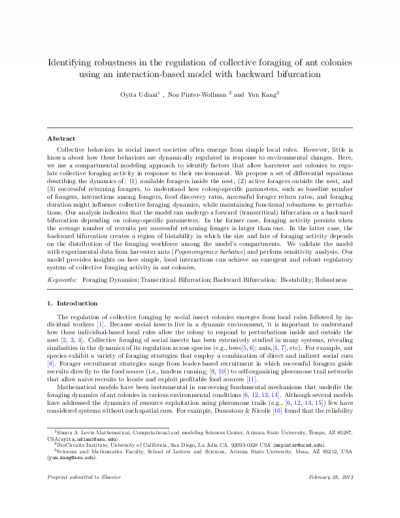Identifying Robustness in the Regulation of Collective Foraging of Ant Colonies Using an Interaction-Based Model With Backward Bifurcation

Collective behaviors in social insect societies often emerge from simple local rules. However, little is known about how these behaviors are dynamically regulated in response to environmental changes. Here, we use a compartmental modeling approach to identify factors that allow harvester ant colonies to regulate collective foraging activity in response to their environment. We propose a set of differential equations describing the dynamics of: (1) available foragers inside the nest, (2) active foragers outside the nest, and (3) successful returning foragers, to understand how colony-specific parameters, such as baseline number of foragers, interactions among foragers, food discovery rates, successful forager return rates, and foraging duration might influence collective foraging dynamics, while maintaining functional robustness to perturbations. Our analysis indicates that the model can undergo a forward (transcritical) bifurcation or a backward bifurcation depending on colony-specific parameters. In the former case, foraging activity persists when the average number of recruits per successful returning forager is larger than one. In the latter case, the backward bifurcation creates a region of bistability in which the size and fate of foraging activity depends on the distribution of the foraging workforce among the model׳s compartments. We validate the model with experimental data from harvester ants (Pogonomyrmex barbatus) and perform sensitivity analysis. Our model provides insights on how simple, local interactions can achieve an emergent and robust regulatory system of collective foraging activity in ant colonies.
- Author (aut): Udiani, Oyita
- Author (aut): Pinter-Wollman, Noa
- Author (aut): Kang, Yun
- Contributor (ctb): Simon M. Levin Mathematical, Computational and Modeling Sciences Center
- Contributor (ctb): School of Human Evolution and Social Change




